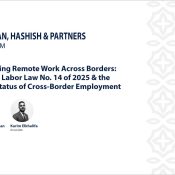Interested in starting a new business in Egypt?
Soliman, Hashish & Partners is constantly in the media spotlight!
Scholarship for studying the Master of Laws in International Trade Law at International Training Centre of ILO
All Categories
- Insights (127)
- Firm News (59)
- CSR (10)
- COVID-19 (2)
- Briefings (67)
- Antitrust (1)
- Banking & Finance (20)
- Corporate (20)
- Corporate Crimes (3)
- Dispute Resolution (5)
- Employment (4)
- Energy & Electricity (2)
- Intellectual Property Rights (1)
- Mergers & Acquisitions (1)
- Real Estate (2)
- Telecoms, Media & Technology (10)
Recent News
Government Procurement in Egypt – SH&P Contribution to Lexology In-Depth 2025
LAW Middle East Features Mohamed Hashish: A Story of Purpose and Resilience
Ministry of Investment Imposes Temporary Measures on Imported Iron and Steel Products
SH&P’s Lexology Panoramic Publication on Foreign Investment Regulation 2025
SH&P’s Lexology Panoramic Publication on Private M&A 2025
New Labour Law No. 14 of 2025

- Managing Partner
- Managing Associate
- Associate
- Junior Associate
- Junior Associate
1- Introduction
The Egyptian Government has adopted the New Egyptian Labour Law No. 14 of 2025 (“New Labour Law”), representing significant effort toward modernizing the labour framework, while aligning it more closely with current market realities and international labour standards.
The New Labour Law, published in the Official Gazette on May 3, 2025, introduces major updates across various areas, including contractual terms, employee rights, modern employment arrangements and compliance mechanisms.
It features new provisions to address previously unregulated issues and critical amendments to outdated norms that had lost their effectiveness.
Entry into Force
The New Labour Law shall enter into force on the first day of the month following the expiration of ninety days from its publication date, therefore it will be effective on
September 1st, 2025. This New Labour Law shall replace the long-standing Labour Law No. 12 of 2003 (the "Old Labour Law").
2- Scope of Application
The provisions of the New Labour Law shall govern employment relationships within private sector in Egypt, particularly matters not explicitly addressed in individual employment contracts or collective labour agreements, including those applicable to foreign employees.
However, this law does not apply to employees classified as “Civil Servants” or domestic workers.
3- Definition of Salary
The New Labour Law retains the definition of “Salary” as set out in the Old Labour Law, encompassing all forms of employee compensation, whether fixed or variable, in cash or in kind. However, it introduces specific definitions for fixed and variable salary. The “Fixed Salary” is defined as the amount stipulated in the employment contract, along with any subsequent allowances or increments.
In contrast, the Variable Salary includes all other elements of compensation received by the employee, such as commissions, bonuses, allowances, in-kind benefits, and gratuities.
Additionally, the New Labour Law establishes clear definitions for both gratuity and service charge, expressly recognizing each as a component of the variable salary.
Under the New Labour Law, gratuity is defined as the compensation received by an employee from a party other than the employer, provided such payment is customary and governed by rules that permit its determination according to the establishment's regulations or prevailing practices.
On the other hand, service charges refer to the compensation that may be paid by customers in tourism, hotel, and other establishments.
4- Equality, Non-discrimination, Harassment and Bullying
While the Old Labour Law limited the prohibition of discrimination to salaries, the New Labour Law expands this prohibition to encompass any act, conduct, or procedure that results in discrimination or differentiation among employees.
Specifically, it prohibits discrimination related to training, job advertisements, recruitment, conditions or terms of employment, as well as the rights and obligations arising from the employment contract. Discrimination based on religion, belief, gender, origin, race, colour, language, disability, social status, political or trade union affiliation, geographic location, or any other reason that undermines the principles of equality and equal opportunity is strictly prohibited.
Furthermore, the New Labour Law explicitly defines forced labour, harassment, and bullying, adopting a stringent approach to these issues. It strictly prohibits all forms of harassment, bullying, or any verbal, physical, or psychological violence directed at employees. In addition, it imposes severe penalties for individuals or entities committing any such acts.
5- Modern Employment Arrangements
The New Labour Law recognizes and regulates modern forms of employment arrangements, distinguishing them from traditional employment relationships in both the manner of work performance and the execution of employee obligations. It explicitly identifies the following types of modern employment arrangements:
- Remote Work: An arrangement in which work is performed at a location other than the employer’s conventional workplace, using technological means.
- Part-Time Work: An arrangement whereby the employee works fewer hours than those required for a comparable full-time position.
- Flexible Work: An arrangement involving the same total number of required working hours, performed at non-consecutive times as agreed by the parties, or allowing variation in the timing, duration, or location of work.
- Job Sharing: An arrangement in which two or more employees share the responsibilities and working hours of a single position and receive proportionate remuneration in accordance with their agreement.
- Other Forms: Any additional form of employment as may be determined by decision of the competent Minister.
In this context, the New Labour Law affirms that the provisions applicable to traditional employment relationships shall also apply to those in modern employment arrangements, subject to appropriate adjustments that account for the distinctive characteristics of such arrangement. It further permits execution of employment in either written or electronic form.
Moreover, under a modern employment contract, an employee may concurrently engage in employment with another employer, provided that all confidentiality and non-compete obligations are strictly observed.
6- List of Employees to be Sent to Competent Authority
Under the New Labour Law, the obligation to submit an annual report remains in effect, to be submitted in January of each year. The report must include updates on employee information, job vacancies, and estimated staffing needs.
Additionally, employers are required to submit an initial report within thirty days from the date of commencement of operations. It must provide a detailed statement of the number of employees categorized by their qualifications, vacancies, nationalities, gender, and the salaries they receive. This timeframe extends from the previous requirement of 15 days as stipulated under the Old Labour Law.
7- Labour Office Registration Certificate
The New Labour Law has revised the submission deadline for the Labour Office Registration Certificate. Employers can now submit this certificate to the Labour Office within 45 days from the date the employee commences work, an extension from the previous thirty 30 days stipulated in the Old Labour Law.
8- Electronic or Physical Register for Employees with Disabilities
Under the New Labour Law, employers are required to maintain either a physical or electronic register to record the names of employees with disabilities and those with dwarfism who possess rehabilitation certificates or disability and integrated services cards. The competent administrative authority shall have the right to access these records upon request.
9- Training and Rehabilitation Fund
The New Labour Law has introduced a notable change regarding the Training and Rehabilitation Fund, which had constituted a source of legal uncertainty and disputes under the Old Labour Law. Previously, the Old Labour Law mandated that employers employing more than ten employees were obligated to contribute one percent of their net profits to the Funds, a provision that gave rise to numerous lawsuits before the Supreme Constitutional Court.
To resolve these concerns, the New Labour Law mandates that employers with thirty or more employees shall contribute 0.25 per cent of the minimum social insurance salary, with a minimum of EGP 10 (ten Egyptian pounds) and a maximum of EGP 30 (thirty Egyptian pounds) for each employee. This contribution is to be borne and paid annually by the employer.
Additionally, all disputes in cases that have not been concluded by a binding judgment and are registered or pending before any court of varying degrees - prior to the implementation of the New Labour Law - shall be considered resolved. This is applicable unless the employer submits a request to continue the dispute before the court hearing the case within six months from the date of the New Labour Law's enactment. Furthermore, resolving these disputes should not entitle employers who have made the required payments to reclaim any amounts previously paid.
10- Recruitment Agencies
- Joint-stock companies;
- Limited liability companies;
- Limited partnerships by shares; or
- One-person companies.
To operate, Recruitment Agencies must obtain a license from the Ministry of Labour, subject to specific requirements, including capital requirements, restrictions on foreign ownership, and financial guarantees.
Recruitment Agencies are permitted to charge administrative fees of up to one per cent of the employee’s salary during the first year of employment. After this one-year period, they are prohibited from charging any additional fees to the employee under any circumstances.
In line with the Old Labour Law, the employment of individuals through outsourcing companies are still prohibited under The New Labour Law.
11- Recognition of Technological Means
In line with ongoing technological advancements, the New Labour Law permits the retention of employees’ files in electronic form. Employers are granted the discretion to maintain such files either electronically or in hard copy. These files typically include details pertaining to the employee’s marital status, academic and professional qualifications, salary information, and any disciplinary actions taken.
However, with regards to the required retention period it has been increased to five years from the termination of the employment, instead of one year, as required under the Old Labour Law.
12- Women Employees
Maternity Leave
Notable enhancements have been introduced to maternity leave entitlements for female employees, both in terms of duration and entitlement periods. Under the New Labour Law, female employees are entitled to maternity leave for a total period of four months, encompassing both the pre- and post-childbirth periods. Such amendment marks an increase from the previous entitlement, which limited maternity leave to ninety days, under the Old Labour Law.
In addition, a female employee may now take three maternity leaves - during her service- up from two instances under the Old Labour Law. It also maintains the provision that prohibits female employees from working during the 45 days immediately following childbirth under the Old Labour Law.
Significantly, the New Labour Law has abolished the prior requirement—set forth in the Old Labour Law—that a female employee must have completed ten months of service with the employer in order to qualify for maternity leave.
Protection of Employment During Maternity Leave
The New Labour Law, consistent with the provisions of the Old Labour Law, affirms a female employee’s right to return to her original position following maternity leave while retaining all previously acquired rights and benefits. Employers are expressly prohibited from terminating the employment contract on the grounds of the employee’s maternity leave. However, the employer may seek recovering the salary paid during the leave period, if it is proven that the employee engaged in work for another employer during that time.
Termination of Employment by Employee Due to Marriage, Pregnancy, or Childbirth
Consistent with the Old Labour Law, the New Labour Law preserves the female employee’s right to terminate her employment contract due to marriage, pregnancy, or childbirth. To exercise this right, the employee must notify the employer in writing within three months from the date of marriage, confirmation of pregnancy, or childbirth, as applicable.
Working Hours During and After Pregnancy
The New Labour Law introduces an important protective measure for pregnant employees by entitling them to a reduction in daily working hours by at least one hour, starting the sixth month of pregnancy. In addition, it prohibits requiring a female employee to perform overtime work during the entire pregnancy period and for a period of six months following childbirth, thereby reinforcing safeguards for maternal health and wellbeing during and after pregnancy.
Breastfeeding Breaks for Female Employees
The New Labour Law retains the provisions of the Old Labour Law with respect to breastfeeding breaks, without introducing substantive changes. Female employees remain entitled to two additional daily breaks for breastfeeding, each lasting no less than thirty minutes. These breaks are fully paid and are considered part of the normal working hours, with no impact on the employee’s salary. This entitlement remains in effect for a period of two years from the date of childbirth.
Childcare Leave
The New Labour Law introduces certain amendments to this entitlement while retaining key provisions. It maintains the condition that the entitlement applies only where the employer has more than fifty employees and retains the maximum duration of each period of childcare leave at two years.
Notably, the New Labour Law increases the number of times a female employee may take childcare leave during her entire period of service to three instances, up from two under the Old Labour Law. Additionally, the new law imposes further conditions, including a requirement that the employee must have completed at least one year of continuous service with the employer prior to requesting the leave. The interval between the first and second leave periods must be no less than two years.
Display of Women’s Employment Regulations
Under the Old Labour Law, employers with five or more female employees were required to display a copy of the Women’s Employment Regulation in the workplace or in areas frequented by employees. The New Labour Law expands this obligation by requiring employers with only one or more female employee to display the Regulations prominently in the workplace.
13- Provision of Childcare Facilities
The New Labour Law maintains the same requirement concerning childcare facilities. Employers who employ one hundred or more female employees are obligated to establish a nursery or to enter into an agreement with an existing nursery to provide care for the employees’ children.
14- Foreign Employees
The New Labour Law introduces new provisions and significant amendments concerning the employment of foreign nationals in Egypt, as outlined below:
- Expanded Definition of Work: The definition of "work" has been broadened to encompass all forms of employment, including dependent employment, self-employment, freelance work, or work carried out on one’s own account. This expanded scope explicitly includes all professions, trades, crafts, and notably, domestic work such as housekeeping.
- Work Permit Procedures and Fees: The Minister of Labour shall issue a decree setting out the conditions, procedures, and required information for obtaining a work permit, as well as the procedures for its renewal. The decision should also determine the applicable fees— which shall be ranging from EGP 5,000 to EGP 150,000—and the fees for exemptions from the recruitment process.
- Employer Notification Obligation: A new obligation has been imposed on employers to notify the relevant Labour Directorate and competent authorities if a foreign employee is absent from work for fifteen consecutive days without a lawful justification.
15- Employment Contracts
The New Labour Law preserves the classification of employment contracts into definite-term and indefinite-term contracts, as previously established. Significantly, it introduces greater legal certainty by expressly stipulating the circumstances under which an employment contract shall be deemed to be of indefinite term. These circumstances include the following cases:
- When there is no written employment contract in place.
- When no specific duration is mentioned in the contract.
- When the contract was initially agreed upon for a specific duration, both parties continued to execute it without signing a renewal contract after the lapse of its period.
Under the Old Labour Law, a definite-term contract was considered indefinite if both parties continued to fulfil their obligations post-expiry. However, this did not apply to foreign employees, whose contracts were terminated upon expiry and did not convert to indefinite status. The New Labour Law eliminates this exception for foreign employees, meaning that a definite-term contract with a foreign employee will now be classified as indefinite if both parties continue to perform their obligations after its expiration.
16- Execution and Language of Employment Contracts
Under the Old Labour Law, employment contracts were required to be issued in three counterparts: one retained by the employer, one by the employee, and one submitted to the competent Social Insurance Office. The New Labour Law builds upon this framework by mandating that employment contracts be issued in Arabic and in four counterparts, with the additional fourth copy to be submitted to the competent administrative authority (i.e., the Labour Office).
In cases where the employee is a foreign national and does not speak Arabic, the employment contract may be issued in both Arabic and the employee’s native language. However, in the event of any inconsistency or conflict between the two versions, the Arabic version shall prevail in the context of any legal dispute.
However, in the absence of a written employment contract, both the employer and the employee retain the right to establish the existence of the employment relationship and all related rights and obligations through any legally admissible means of proof. Unlike the Old Labour Law, which granted this evidentiary right solely to employees.
17- Salary Payment
The New Labour Law retains the core provisions governing the payment of salaries as set out in the Old Labour Law. Moreover, it introduces an additional mechanism by explicitly permitting employers to transfer employees' salaries directly to their bank accounts.
18- Working Hours
The New Labour Law retains the provisions of the Old Labour Law concerning working hours, overtime, and break durations. However, a significant change is introduced regarding overtime procedures. Unlike the Old Labour Law, which mandates obtaining prior written approval from the administrative authority for overtime, the New Labour Law streamlines this process. Under the new framework, the employer is required to notify the competent administrative authority within seven days of the occurrence of exceptional or abnormal working conditions, providing the justifications for the additional work and the estimated time required to complete the task. This change eliminates the need for prior written approval from the authority.
19- Leaves
Annual Leave
The New Labour Law provides new regulations regarding annual leave, whereby an employee is entitled to only fifteen days of leave during the first year of employment. This entitlement increases to twenty-one days starting the second year of employment. Additionally, any employee who has worked for more than ten years with the same employer or more shall be entitled to an annual leave balance of thirty days.
The Old Labour Law granted twenty-one (21) days of annual leave only upon completion of a full year of employment, Furthermore, employees who had not completed a full year were eligible for pro-rated leave based on the actual duration of their service, provided they had worked for at least six months.
Annual Leaves for Employees with Disability and Persons with Dwarfism
The New Labour Law introduces, for the first time, specific provisions addressing the rights of employees with disabilities and individuals with dwarfism. These employees are entitled to an extended annual leave of forty-five calendar days. In addition, the law stipulates that, for these categories of employees, annual leave may not be divided, accumulated, or carried forward to subsequent years.
Exam Leave
The New Labour Law retains provisions similar to those in the Old Labour Law regarding exam leave for student employees. A student employee retains the right to determine the date of their annual leave during exams, provided that the employer is notified in advance. Significantly, the New Labour Law introduces an additional entitlement whereby a student employee is granted paid leave on the actual day of the examination. This paid leave is not to be deducted from the employee’s annual leave. However, the exercise of this right is subject to certain conditions, including the obligation to notify the employer ten days in advance and to provide appropriate documentation evidencing attendance of the exam.
Emergency Leave
The New Labour Law has amended the provisions regarding emergency leave, which were previously set forth in the Old Labour Law. Employees are now entitled to seven days of emergency leave, up from six days provided under the former law. It is further stipulated that no more than two days of emergency leave may be taken consecutively.
Paternity leave
For the first time, the New Labour Law grants paternity leave on the day of childbirth to male employees. This leave is fully paid and shall not be deducted from the employee’s leave balance. However, an employee can take up to three paternity leaves throughout their entire period of service.
Official Holidays
The New Labour Law maintains provisions similar to those set out in the Old Labour Law regarding official holidays, with minor modifications. Under the New Labour Law, an employee who works on an official holiday is entitled, in addition to their regular salary for that day, to either double that salary or a compensatory day off, subject to a written request submitted by the employee.
Furthermore, the provisions of the Cabinet of Ministers decree regarding non-Muslim religious holidays shall apply.
Importantly, the New Labour Law eliminates the previous threshold for official holidays set by the Old Labour Law, which limited the number of official holidays to 13. This limitation has been removed and is not included in the New Labour Law.
Sick Leave
Upon proving illness in industrial establishments governed by the Law on Facilitating the Granting of Industrial Establishment Licenses issued under Law No. 15 of 2017, employees shall be entitled to sick leave every three years of service. The leave shall be granted as follows: three months with full pay, followed by six months with 85 per cent of their salary, and then three months with 75 per cent of their salary. This shall be applied only after the competent medical authority determines that the employee is likely to recover from the illness.
In addition, the New Labour Law empowers the competent medical authority to suspend an employee from performing their duties for a suitable period—up to three months—if the employee has been in contact with a family member suffering from a contagious disease. The types of such diseases, as well as the competent medical authority, shall be specified by a decision issued by the Minister of Health.
20- Employees’ Test
A new provision under the New Labour Law mandates that employees must undergo medical testing for drug use or infectious diseases upon the employer’s request, with the costs borne by the employer. These tests are to be conducted by the General Authority for Health Insurance or the Central Laboratories of the Ministry of Health.
Drug testing and related grievance procedures will be carried out in accordance with regulations and guarantees to be issued by the Minister of Labour. These regulations will include provisions for same-day re-testing of samples. If the results of the initial and follow-up tests differ, a confirmatory analysis must be conducted by one of the designated authorities mentioned.
In all cases, the employer is obligated to maintain confidentiality regarding the employee’s health status and test results.
21- Disciplinary Sanctions
The New Labour Law largely retains the disciplinary framework established under the Old Labour Law, including the requirement to investigate the employee prior to imposing any disciplinary sanction, in accordance with a prescribed timeframe.
However, it introduces several notable changes. Any warning issued to the employee must be in writing. Additionally, any deductions or reductions must be made from the employee’s fixed salary.
Significantly, the New Labour Law introduces a provision allowing the imposition of a more severe sanction in cases of repeated violations, provided that the subsequent infraction occurs within one year from the date the employee was notified of the previous sanction. This reflects an extension of the recurrence period previously established under the Old Labour Law, which was limited to only six months.
22- Resignation and Withdrawal
The New Labour Law introduces a distinct regulatory framework concerning employee resignation. It stipulates that a resignation must be submitted to the employer, to be duly signed by the employee or their authorized representative and certified by the competent administrative authority.
Furthermore, the employee is entitled to continue working until the employer responds to the resignation within ten days. If no response is given within this period, the resignation shall be automatically deemed accepted.
Unlike the Old Labour Law, which limited the right to withdraw a resignation to one week, the New Labour Law extends this period to ten days from the date of the employer’s acceptance. In all cases, the withdrawal must be in writing and certified by the competent authority.
23- Termination of Employment Contract
Termination of Definite Term Employment Contracts
Unlike the Old Labour Law, which lacked an explicit provision regulating compensation for the termination of definite-term employment contract – thus leaving the determination to judicial discretion, where courts typically awarded compensation equivalent to the employee’s salary for the remaining term of the contract or based on actual damages in accordance with the Civil Code - The New Labour Law introduces a clear provision in this regard.
Under the New Labour Law, if a definite-term employment contract is terminated by the employer prior to its expiry, the employee is entitled to compensation equivalent to one-month salary for each year of service.
Termination of Indefinite Term Employment Contracts
Under the New Labour Law, compensation for unlawful termination of indefinite-term employment contracts by the employer remains consistent with the Old Labour Law, providing a minimum of two-month salary for each year of service.
However, the New Labour Law introduces a unified notice period for the termination of indefinite-term employment contracts, now set at three months, regardless of the employee’s length of service. This replaces the previous framework under the Old Labour Law, which required a notice period of two months for employees with less than ten years of service, and three months for those with more than ten years of service.
In all cases, the employer may terminate the employment contract if the employee commits a gross violation.
Furthermore, the New Labour Law introduces a significant provision granting employees the right to terminate the employment contract if the employer fails to fulfill a fundamental obligation arising from the Law itself, the employment contract, or the employer’s internal regulations. This right also extends to situations where the employee, or a relative thereof, is subjected to assault by the employer or its representatives. In such cases, the termination is legally deemed equivalent to an unfair dismissal initiated by the employer. As a result, the employee becomes entitled to compensation for unfair dismissal, in addition to any other financial entitlements.
24- Specialized Labour Courts
As part of the ongoing judicial reforms aimed at strengthening labour rights and streamlining dispute resolution, specialized labour courts will be established, effective October 1st, 2025, within the jurisdiction of each primary court ("Specialized Labour Courts"). Additionally, designated appellate circuits will be created within each court of appeal to hear challenges to rulings issued by the Specialized Labour Courts, with the possibility of further appealing these decisions to the Court of Cassation.
However, appeals to the Court of Cassation in employment-related cases will be restricted. Such appeals will only be permitted in cases involving custodial sentences. To address these exceptions, specialized circuits will be established within the Court of Cassation to hear eligible employment-related appeals.
Furthermore, the Specialized Labour Courts shall have exclusive jurisdiction over disputes arising from the application of all laws and regulations governing employment relations. This includes lawsuits pertaining to the insurance rights of employees and their beneficiaries, as well as matters related to labour unions and their organizations. These courts' jurisdiction shall be exercised without prejudice to the jurisdiction of the administrative courts.
With respect to ongoing lawsuits, the New Labour Law mandates that courts shall refer any disputes or cases to the Specialized Labour Courts. Such referrals will be made in their current state and without associated fees.
However, cases that have already been ruled on or are pending judgment before the enforcement of the New Labour Law will remain under the jurisdiction of the original courts. Such cases will continue to be adjudicated, and any judgments issued will remain subject to the rules governing appeals in effect at the time of their issuance.
25- Penalties
The New Labour Law introduces substantially higher financial penalties for employers who fail to comply with its provisions, in comparison to the penalties stipulated under the Old Labour Law. These enhanced penalties are designed to provide a stronger deterrent against violations, including but not limited to, failure to pay salaries, the absence of formal employment contracts, non-compliance with occupational safety standards, and breaches related to working hours or employee rights.
By substantially increasing the costs associated with non-compliance, the New Labour Law aims to encourage a shift in employer behavior towards full adherence to legal obligations. This shift not only enhances protections for employees but also contributes to improved overall conditions in the labor market. Through these measures, the law seeks to ensure fair treatment in the workplace, fostering a more accountable and equitable labor environment for all parties involved.
Conclusion
The New Labour Law signals a decisive shift in Egypt’s approach to regulating the labour market, emphasizing legal accountability, institutional modernization, and enhanced employer protections. By reinforcing compliance mechanisms and redefining the roles of key stakeholders, the New Labour Law lays the groundwork for a more transparent, balanced, and enforceable employment framework. Its implementation marks a critical milestone in the country’s broader strategy to foster fair labour practices, attract investment, and align with evolving economic and social priorities.












